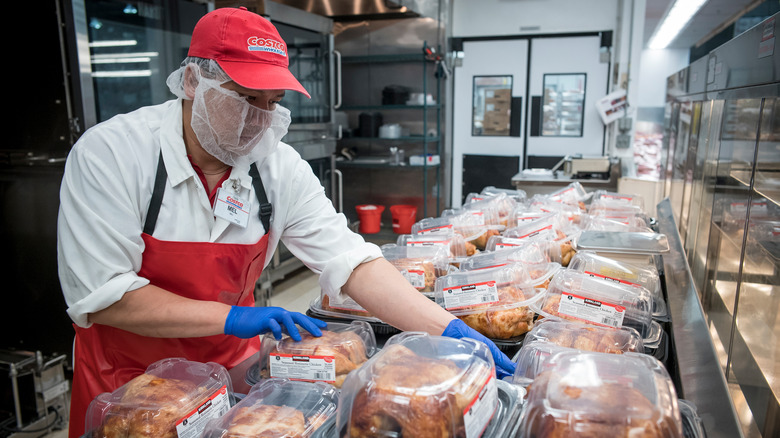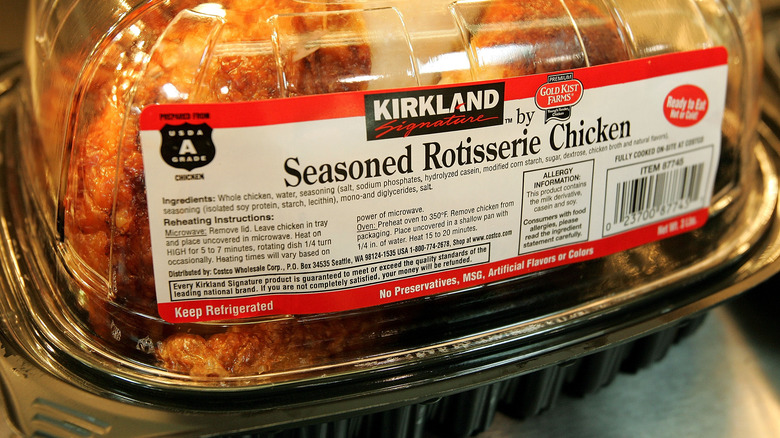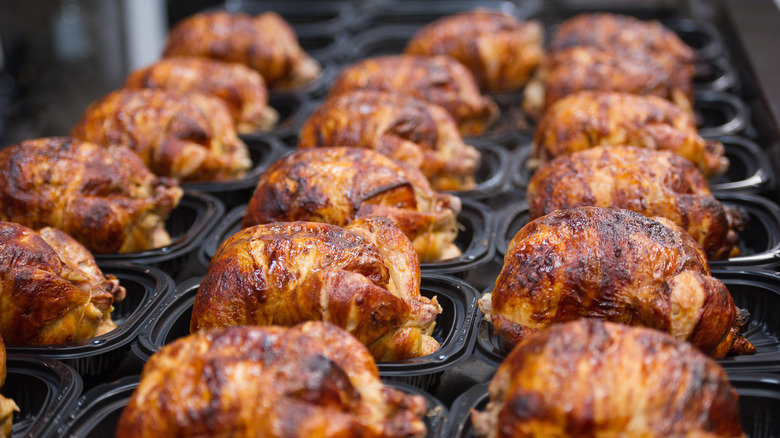Costco's 2-Hour Rule For Rotisserie Chicken Explained
Costco's rotisserie chicken is almost as legendary as the Costco inflation-proof buck-fifty hot dog, with a cult following to match. Forget spending hours poring over recipes and watching your oven like a hawk while a whole chicken cooks from scratch. Just pick up one of these ready-to-go rotisserie chickens, heat it up at home, and voilà — you've got the centerpiece for a weekend family dinner with less than an hour of prep work.
Since Costco offers all that for $4.99, it's really no wonder that it sells millions of these chickens every year. According to Business Insider, the demand is so high that Costco even built its own poultry farming complex in Nebraska to keep supplies plentiful and prices low. But there's more to the frenzy around these chickens than just their taste and value. When Costco brings out a fresh batch, shoppers swarm the shelves immediately. The hurried pace isn't just because people want to snag the freshest Costco rotisserie chickens for themselves but more because veteran shoppers know the drill: Employees remove the chickens from the shelves after two hours, so you've got to act fast.
So what's up with the peculiar sell-by window? Naturally, you'd think that the only reason a big-box store such as Costco would willingly pull food items from the shelves is because they're no longer viable or safe to eat. Surprisingly, this isn't the case. It's simply because Costco thinks its chickens no longer taste as good after two hours!
Are Costco's rotisserie chicken safe to eat after two hours?
According to the book "The Joy of Costco: A Treasure Hunt from A to Z" by Costco superfan couple David and Susan Schwartz, the store has been pulling its rotisserie chickens off the shelves after two hours on display for years.
While Costco keeps the exact shelf-life of its rotisserie chickens under wraps, considering the number of (USDA-approved) preservatives that go into each chicken, there's no way that the chickens would truly spoil after spending just two hours on the shelves. According to Consumer Reports, the chicken is often injected with a saline solution to keep it fresh, plump, and flavorful. Additionally, Costco chicken includes sodium phosphate, a food preservative that extends its shelf-life. So even if you're cutting it close to the end of the two-hour sell-by time when you snag that plump rotisserie chicken, rest assured that the chicken's still very much safe to eat.
Where unchosen rotisserie chickens go
If you're worried that unsold rotisserie chickens might end up as food waste after their two-hour spotlight on the shelves, the good news is that they aren't thrown out into the bins. Instead, they're repurposed into other food offerings at Costco. The Schwartzes mention in their book that the leftover chicken is processed further by the kitchen in the back and given a second lease on life as ingredients in Costco's soups and chicken salads.
One product that makes use of the repurposed rotisserie chicken is the Southwest Rotisserie Chicken Wrap. You can get it in the store's grocery section, and according to Parade, it sold for $6.99 per pound in 2023. In this product, meat from leftover rotisserie chicken is used as filling and mixed with a variety of vegetables and spices to give you that southwest flavor-in-a-roll. Many shoppers love the chicken wraps for their tastiness, but quite a few people also deride the wraps for their price. Each wrap, weighing a pound each, is more expensive than a whole chicken. But on the bright side, even if you're not a big fan of the pricey chicken wraps, it should still be nice to hear that Costco doesn't just throw away perfectly edible chickens after just two hours on the shelves.


